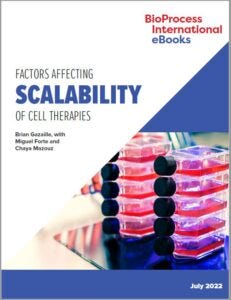eBook: Factors Affecting Scalability of Cell TherapieseBook: Factors Affecting Scalability of Cell Therapies
 The number of cell and gene therapies in different phases of development is increasing. The industry currently needs to increase commercial good manufacturing practice (GMP) capacity to keep up with current and future demands. Cell and gene therapy scale-up from clinical to commercial capacity levels can reduce cost of goods and thus price per dose. An optimized bioprocess facilitates scale-up from hundreds (clinical scale) to thousands of doses (commercial scale). Different approaches for increasing scale can be taken. For example, some strategies require moving from a two-dimensional, adherence-based cell culture platform to a three-dimensional, suspension-based system in bioreactors. The implementation of closed, automated process environments, especially for autologous therapies, also can increase scalability and improve accessibility for patients.
The number of cell and gene therapies in different phases of development is increasing. The industry currently needs to increase commercial good manufacturing practice (GMP) capacity to keep up with current and future demands. Cell and gene therapy scale-up from clinical to commercial capacity levels can reduce cost of goods and thus price per dose. An optimized bioprocess facilitates scale-up from hundreds (clinical scale) to thousands of doses (commercial scale). Different approaches for increasing scale can be taken. For example, some strategies require moving from a two-dimensional, adherence-based cell culture platform to a three-dimensional, suspension-based system in bioreactors. The implementation of closed, automated process environments, especially for autologous therapies, also can increase scalability and improve accessibility for patients.
In this eBook, associate editor Brian Gazaille speaks with Miguel Forte (chief executive officer of Bone Therapeutics) and Chaya Mazouz (vice president of quality (Israel) and global regulatory affairs at Orgenesis) about the different facets of successful cell and gene therapy scale-up. Although the process timelines for allogeneic and autologous cell therapies differ, the same factors should be considered regarding process scalability. Forte and Mazouz discuss the importance of maintaining comparability throughout the scale-up process and ensuring characterization consistency by conducting potency assays. Other essential aspects of a cell and gene therapy scale-up strategy include critical quality attributes documentation, high-quality starting materials, process optimization, donor selection, and raw-material consistency.
Fill out the form below to read the eBook now.
You May Also Like





